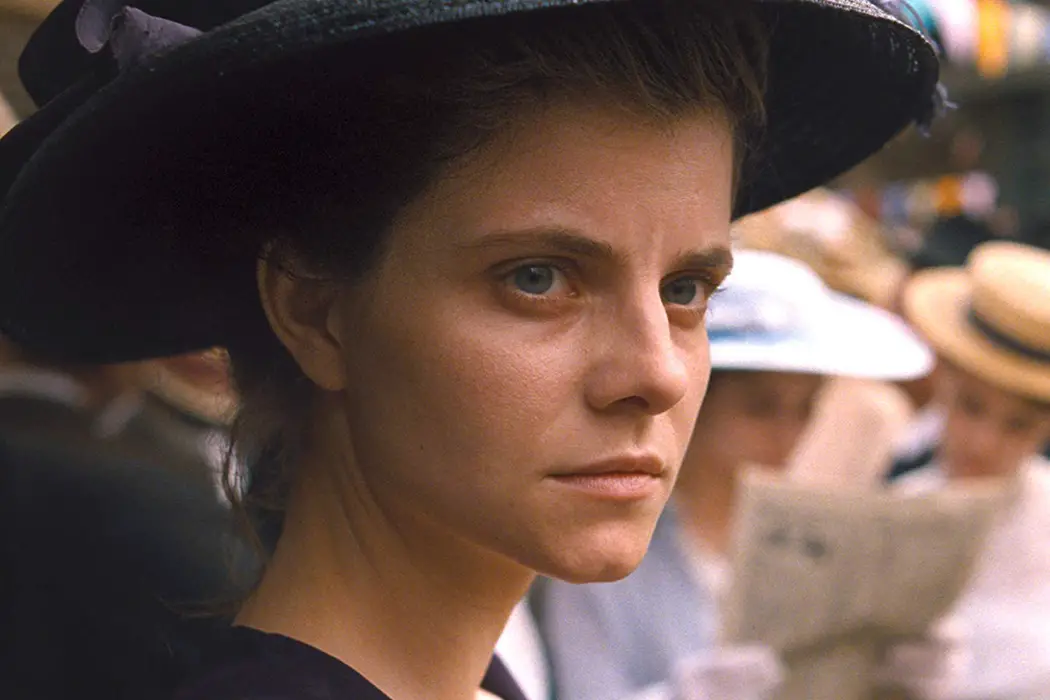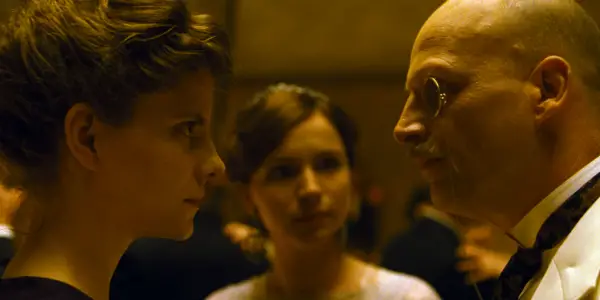SUNSET: Chaos Prevails In Nemes’ Staggering Masterpiece

Gus is a 3rd year English Lit and Creative Writing…
There’s no silence in Sunset. It’s all droning violins and background noise: the baying of a horse; the wheels of a cart; the hushed talk of townsfolk. It lasts right up until the credits finish rolling. It’ll last longer, if the film manages to get into your head. You should let it.
László Nemes’ follow-up to his acclaimed debut, Son of Saul, is the best film of the year so far. It may very well end up staying that way. It is a film that perfectly captures an era, yet resonates way beyond its time frame. It is a film that forces the reader to interrogate the image and assume the role of its protagonist. It is a film where reason is redundant and chaos is constant. It is an extraordinary visual feast, a feat of unconventional storytelling, a baptism of fire, a thrilling rise and fall, and a tale of the societal failings we’re doomed to repeat. It is a film about hats. More on that later.
Confusion & Hysteria In Pre-War Budapest
In 1913, the Austro-Hungarian Empire is on the brink of collapse, and Juli Jakab’s Írisz Leiter is there to witness it. Returning to her childhood city, she braves the bustling sepia streets of Budapest to work at the millinery that once belonged to her long-dead parents. The current proprietor, a stone-faced gent named Oskzár Brill (Vlad Ivanov), initially refuses to have her on board. The ‘Leiter’ name is stained, you see, by the devilish actions of Írisz’s long-lost brother. But she’s adamant to join, and her persistence reaps rewards. With a group of anarchists looming in the background and rumours of the brother’s return, it also reaps the reaper itself.

And that’s as far as I’ll go with the plot. That’s probably as far as you’ll go, too. Sunset plays out as if Thomas Pynchon set his eyes on a costume drama, all meandering mystery and carefully constructed chaos. Narrative, meanwhile, is on the back burner. There’s progression, sure, but it’s difficult to discern the specifics of it all. This chronicle in history is meant to be inhaled and held in until it’s impossible to breathe – it’s the act of storytelling via asphyxiation.
Nemes makes sure the stranglehold is permanent. Wielding the same staggering technique he used in Son of Saul, he pins the frame to Írisz’s neck as she wanders through the dusty funk. The PoV bears the uncanny resemblance of a video game—picture Assassin’s Creed, relocated to pre-war Budapest. Her surroundings are reduced to bokeh; squint hard enough, and it looks like she’s wading through an oil painting. The world dictates the camera, and not the other way around.
In turn, fissures emerge, mise-en-scène appears as one wriggling mass, and the audience are dislodged from their bearings. Call it suffocating, frustrating, a headache, call it whatever you want—you’re feeling exactly what Nemes wants you to feel, and exactly what Írisz is experiencing. It’s at once distancing, and fiercely immersive.
This immense confusion and chaos felt during the dying embers of the Austro-Hungarian empire is Sunset’s smokescreen, and where there’s smoke, there’s fire. If you allow yourself to buy into its foggy atmosphere, then Nemes discloses not just how this empire came to a close, but why. And all roads lead to those hats.

A Corrupt World Hidden Behind Hats
The millinery is a grand establishment, rebuilt from the scorched property of Írisz’s parents, while maintaining their name and profession. It’s also a symbolic, dissertation-prompting goldmine, each of its components revealing the machinations of a climate tottering on the precipice of war. This company is plucked from the same sociopolitical stew as the bordello in Bertrand Bonello’s House of Tolerance, its tiers of workers stifling under a capitalist grip, with a head honcho operating under the whims of a higher power (here, it’s a group of royals).
If ‘the horror of the world’ is said to lie behind Sunset’s opulent hats, then the same can be said of the millinery itself: dolled up in a grand, gorgeous design that belies its decadence, the corrupt foundations slowly make themselves known as Írisz journeys further down the rabbit hole. Indeed, the hats—ornate objects serving to distract and conceal—are symbiotic with this corruption. The more lavish the hat, the richer you are, and the more you have to hide.

So the royals that drop by the establishment—their arrival in Budapest masquerading as a celebration—have many a secret to stash away. Their part to play in Írisz’s narrative produces one of the film’s most horrifically surreal sequences, a gradual uncloaking of regal debauchery that draws the story’s strands closer while still leaving them splayed. Here, the microcosmic scale Sunset operates under is scathing, and Nemes takes this furor and injects it into his narrative’s astonishing dual denouements.
These denouements—a jaw-dropping staging of an inevitable societal rebellion—are effective not just because of how abruptly they pierce through Sunset’s methodical build-up of intrigue, but also because of what they say about our place in humanity. Nemes stakes the claim that we’re tottering towards an era-defining insurgence, and who’s to say we don’t deserve it? Who’s to say we shouldn’t be a part of it? Who’s to say that it’ll change anything?
Sunset: Conclusion
Nemes’ masterpiece ruminates on the cyclical ignorance of humanity to blistering effect, eliding our past faults, our present negligence and our future turmoil. If its coda perhaps crystallises a message easier to swallow when left oblique, that’s only to emphasise the urgency necessary to address our societal failings before our own sunset succumbs to total darkness. And what’s Írisz’s role in all of this? She moves through her shifting surroundings with confidence and without purpose. She carries agency and changes nothing. Her eyes are attentive, her face concentrated, yet she acts as if she hasn’t taken in any of the advice doled out to her by the narrative’s various bit-part players.
She exists on another plane altogether, an outsider free from the ingrained social squalor of Budapest. Where some languish in a state of living rife with capitalist corruption and brewing tensions, and others give in to the growing tumult, she commits to neither. She’s our angel of death, an observer of our constant regression to the mean and our unwillingness to do anything about it. “It’s starting all over again”, laments a hatmaker to our protagonist. She’s not wrong. Írisz has seen the horror of the world stretch out over Sunset’s runtime, and she’ll see it over and over again, until there’s nobody left to repeat the same mistakes.
Have you seen Sunset? What are your favourite anti-narrative films? Let us know in the comments below!
Sunset was released in the U.S. on March 22nd. It currently has no U.K. release date. For all international release dates, click here.
Does content like this matter to you?
Become a Member and support film journalism. Unlock access to all of Film Inquiry`s great articles. Join a community of like-minded readers who are passionate about cinema - get access to our private members Network, give back to independent filmmakers, and more.
Gus is a 3rd year English Lit and Creative Writing student who loves everything film and still doesn't understand why he didn't study that instead. He is the co-editor for Venue, the arts supplement of his Uni's newspaper, and has written for Little White Lies, ScreenRant, Dog and Wolf, BritFlicks and Outline Norwich.












